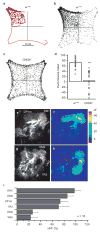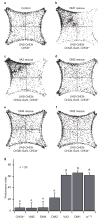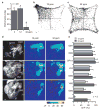Select Drosophila glomeruli mediate innate olfactory attraction and aversion
- PMID: 19396157
- PMCID: PMC2702439
- DOI: 10.1038/nature07983
Select Drosophila glomeruli mediate innate olfactory attraction and aversion
Abstract
Fruitflies show robust attraction to food odours, which usually excite several glomeruli. To understand how the representation of such odours leads to behaviour, we used genetic tools to dissect the contribution of each activated glomerulus. Apple cider vinegar triggers robust innate attraction at a relatively low concentration, which activates six glomeruli. By silencing individual glomeruli, here we show that the absence of activity in two glomeruli, DM1 and VA2, markedly reduces attraction. Conversely, when each of these two glomeruli was selectively activated, flies showed as robust an attraction to vinegar as wild-type flies. Notably, a higher concentration of vinegar excites an additional glomerulus and is less attractive to flies. We show that activation of the extra glomerulus is necessary and sufficient to mediate the behavioural switch. Together, these results indicate that individual glomeruli, rather than the entire pattern of active glomeruli, mediate innate behavioural output.
Figures






References
-
- Hildebrand JG, Shepherd GM. Mechanisms of olfactory discrimination: converging evidence for common principles across phyla. Annu Rev Neurosci. 1997;20:595–631. - PubMed
-
- Bargmann CI. Comparative chemosensation from receptors to ecology. Nature. 2006;444:295–301. - PubMed
-
- Vosshall LB, Amrein H, Morozov PS, Rzhetsky A, Axel R. A spatial map of olfactory receptor expression in the Drosophila antenna. Cell. 1999;96:725–36. - PubMed
-
- Goldman AL, Van der Goes van Naters W, Lessing D, Warr CG, Carlson JR. Coexpression of two functional odor receptors in one neuron. Neuron. 2005;45:661–6. - PubMed
-
- Fishilevich E, Vosshall LB. Genetic and functional subdivision of the Drosophila antennal lobe. Curr Biol. 2005;15:1548–53. - PubMed
Publication types
MeSH terms
Substances
Grants and funding
LinkOut - more resources
Full Text Sources
Other Literature Sources
Molecular Biology Databases

